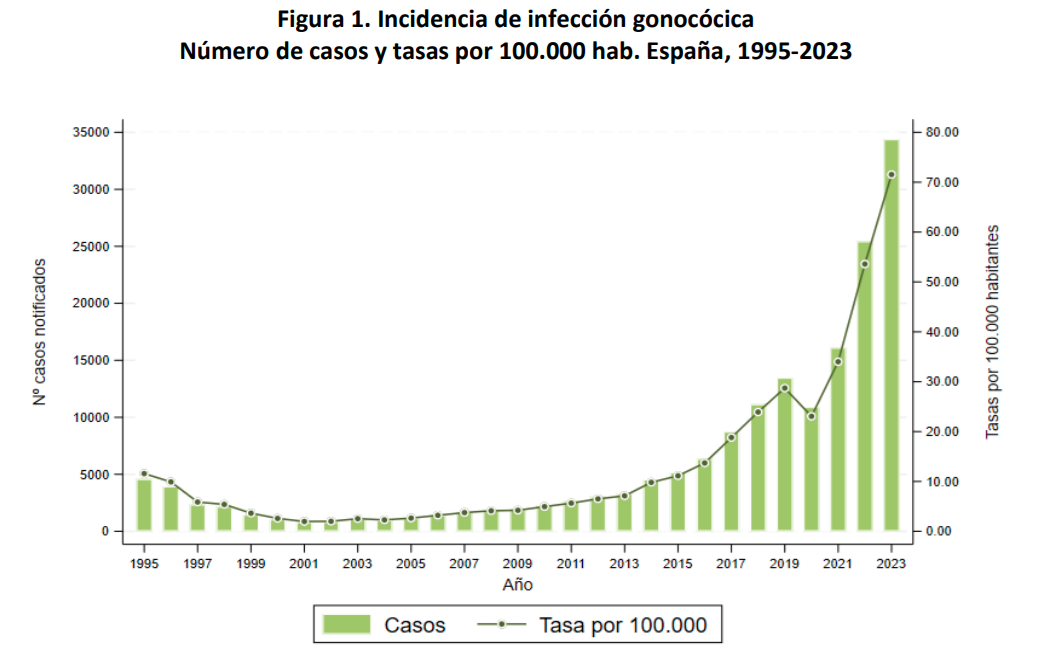In two years, the incidence of gonorrhea doubled, and syphilis by 59%.

Compilation
Sexually transmitted infections (STIs) continued their upward trend in Spain over the past year, with gonococcal infections, or gonorrhea, rising by 42.6% and syphilis by 24.1% between 2021 and 2023, according to estimates , obtained on the basis of the data obtained. in the report Epidemiological surveillance of sexually transmitted infections in Spain, 2023.published this Monday by the National Epidemiological Center of the Carlos III Institute of Health (ISCIII).
Specifically, the report states that there were 34,403 cases of gonococcal infections reported in 2023, compared to 16,115 in 2021 or 25,449 in 2022. For syphilis, there were 10,879 cases reported in 2023, up from 6,841 in 2021 and 8,531 in 2022. The increase in chlamydia incidence was 20.7% annually between 2016 (the first year for which data is available, with 7,239 cases) to 2023 (36,983 cases).
Taking into account the number of absolute cases, the number of gonorrhea infections has doubled in two years, and the growth rates would be higher than predicted by the Ministry of Health. However, the ISCIII analysis was conducted using a methodology that offers annual percentage change (PAC), a metric that helps assess whether the number of cases of a disease is increasing or decreasing over time. This percentage reflects the relative change over the year, which is useful for identifying trends in infections. The formula for calculating the annual percentage change is based on an adjustment for the average growth rate.
There were 34,403 cases of gonococcal infection reported in 2023, up from 16,115 in 2021 or 25,449 in 2022, the report said.
The incidence of gonococcal infection in autonomous entities in 2023 represents a very wide range – from 9.24 to 165.30 cases per 100,000 inhabitants. The highest rates were recorded in Catalonia (165.30), Madrid (94.08), Basque Country (78.37) and Andalusia (58.64). The lowest rates were recorded in Ceuta (1.20), Melilla (2.34), Aragon (9.24), Castile and Leon (12.59) and Extremadura (16.12).
Of the total reported cases, 44.2% (15,216 cases) had transmission information. Of these, 39.3% corresponded to homosexual relationships between men, 5.8% to men with heterosexual relationships, 17.2% to heterosexual relationships among women, 34.5% to men with unspecified sexual transmission and 3.2% to women with unspecified sexual intercourse. In eight cases diagnosed in newborns, the virus was transmitted from mother to child.
There were 10,879 cases of syphilis in 2023, up from 6,841 in 2021 and 8,531 in 2022.
Regarding syphilis cases, the autonomous communities that reported the highest rates in 2023 were the Canary Islands (53.91), the Balearic Islands (33.97), Madrid (32.52) and Catalonia (30.54). The lowest incidence was in La Rioja (2.17), Castile-La Mancha (3.36) and Aragon (6.11).
As with gonococcal infection, rates were higher in men (40.66) than women (5.27), and the age group with the highest rates was 25 to 34 years (64.97 per 100,000).
The report also included seven confirmed cases of early congenital syphilis (under two years of age) in 2023. These cases corresponded to five boys and two girls, all of whom were diagnosed in the first months of life.
For Chlamydua trachomatis infection, rates increased between 2016 and 2023. in autonomous communities around the world that have reported cases.
About infection Chlamydia trachomatisBetween 2016 and 2023, rates increased in autonomous communities around the world reporting cases. In 2023, the highest rates were observed in Catalonia (194.56), Navarre (124.97), Basque Country (102.78) and Madrid (85.97). Those with lower scores were Melilla (1.17), Aragon (5.52), Castile and Leon (13.26) and Castilla-La Mancha (13.82). Ceuta reported no cases.
46.6% (17,238 cases) were women, the mean age at diagnosis was 28 years, and women were younger than men (24 years and 31 years, respectively). Most cases occurred between the ages of 25–34 years (36.4%) and 20–24 years (25.6%). The percentage of cases between the ages of 15 and 19 was 9.9%, with 16.2% of the total cases occurring in women and 4.4% in men.
The report warns that it is difficult to compare sexually transmitted infection rates between communities due to differences in their surveillance systems.
Finally, regarding lymphogranuloma venereum (LGV), an infection caused by Chlamydia trachomatis L1-L3, the report indicates that 1807 cases have been reported in the 16 autonomous communities with a surveillance system. The highest rates were observed in Catalonia, the Community of Madrid, Navarre and the Basque Country. The CCAA of Cantabria, Castile-La Mancha, Ceuta and Melilla did not declare any cases of the disease in 2023.
The report warns that it is difficult to compare incidence rates between autonomous communities due to differences in their surveillance systems. Although all communities have individual case declarations, this requires improved data quality, especially regarding mode of transmission.
Spain has launched a plan to prevent and control sexually transmitted infections and HIV until 2030.
To combat the growing problem of STIs, Spain has launched HIV Prevention and Control Plan and STIs 2021-2030.with the goal of eliminating these infections as a public health problem by 2030. The plan is based on a comprehensive approach that includes prevention, early diagnosis, treatment, chronic disease care and improving quality of life, while not forgetting the fight against stigma and discrimination.
In accordance with this plan, the Ministry of Health and the Spanish Society of Infectious Diseases and Clinical Microbiology (SEIMC) have developed new guidelines for the treatment of STIs. These guides will be presented as part of the day Challenges and opportunities in the fight against STIswhich will take place in Valencia this Monday and Tuesday.
